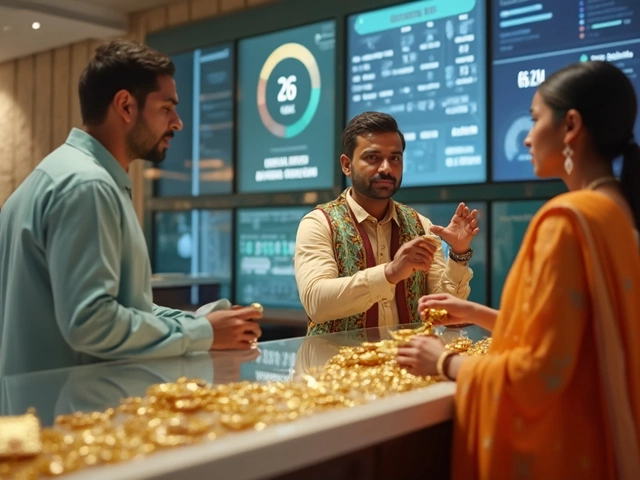
Money in your savings account isn’t just a bunch of numbers on your banking app. It's your sleepless nights, those skipped vacations, the wish to keep your family safe, and sometimes, it’s the hope for something bigger. But what if one day, the bank where your stash is locked up, just...vanishes? Public fear isn’t fiction—remember the Yes Bank crisis in 2020? Even the most “too big to fail” banks can stumble. Choosing where to keep your money is a bigger deal than picking the fanciest debit card design. Safety can’t be just a strong password or a CCTV camera in a branch. Let’s talk real bank safety—where to stash your hard-earned money in India and actually sleep well at night.
What Does "Safest Bank" Actually Mean in India?
Kicking off, the "safest bank in India" isn’t just the one with guards at the gate or best deals on savings accounts. We're talking about banks that can ride out financial disasters, fraud, cyber-attacks, and the random curveballs the world throws. So how do you decide what really makes a bank safe?
Start with Government Backing. In India, the biggest safety net for your bank account comes from public sector banks (PSBs) like State Bank of India (SBI), Bank of Baroda, and Punjab National Bank. They’re majority-owned by the Indian government, and let’s be honest: even if the government has issues, it’s way less likely to let a big PSB collapse. It’s not just about stability—it’s a public trust thing. In extreme situations (like the YES Bank mess), the government and Reserve Bank of India (RBI) have swooped in to protect depositors.
Deposit Insurance is the next shield. Ever heard of DICGC? The Deposit Insurance and Credit Guarantee Corporation is an RBI subsidiary that insures your deposits up to ₹5 lakh per account, per bank. If your bank somehow tanks, DICGC guarantees you’ll get your money back up to this limit. Not a huge sum if you’re sitting on crores, but for most, that's a decent fallback.
Then you have the really technical stuff—Capital Adequacy Ratio (CAR), Non-Performing Assets (NPA) levels, and Net NPA ratios. If you’re not a finance geek, here’s the gist: the higher the CAR, the better the bank’s health (it means the bank has enough capital to handle losses). Lower NPAs? Good sign. High NPAs? Red flag—they’re struggling to get their loans back from borrowers. Consistently clean books show the management isn’t hiding any skeletons.
A safe bank also means solid digital security. In 2023, digital scams doubled, and even major names like HDFC and SBI hit headlines for attempted phishing attacks (thankfully, their systems mostly held up). Big banks spend crores on firewalls, threat monitoring, and AI-based fraud detection.
Stick to banks that publish solid annual reports, have transparent histories, and no scandals. If your “safe” bank is often in the news for all the wrong reasons—maybe skip that one. Nothing beats a bank with a history of over 50+ years without big frauds or government interventions.
Tips to check a bank’s safety yourself? Browse the RBI’s Financial Stability Report. Scan their recent NPAs and capital ratios on https://www.moneycontrol.com/. Dive into customer complaints on Twitter and popular forums (yes, those angry posts can say a lot). Sometimes, the warning signs are all there, we just ignore them for the sake of a more attractive interest rate.
The Top Safest Banks in India Right Now
Now, let’s cut to the chase. Which banks have actually made the cut as the safest bank in India in 2025?
- State Bank of India (SBI): The grand-daddy of Indian banking. Government-owned, loaded with capital, and a reach that covers rural and urban India alike. SBI almost never faces crises. Their technology might feel old-school, but it brings stability. In the last financial year, SBI’s gross NPA fell to under 2.8%—their best in a decade.
- HDFC Bank: Privately owned but acts like a fortress. Highest market cap in the sector, a digital powerhouse, one of the lowest NPA levels among private banks (about 1.2%), and top-notch customer security measures. People love HDFC for smooth online banking and almost zero horror stories of major losses.
- ICICI Bank: You can’t talk private banks without ICICI. After a rough patch in the early 2010s, they’ve worked hard to clean up their act, cut NPAs to just above 1.3%, and maintain strong CAR. Rigorous fraud checks and some of the best cyber patrols. Plus, RBI always keeps a close eye on them.
- Bank of Baroda: Steadily climbing among government banks. It merged with Vijaya and Dena Bank, boosting its spread. Their NPA woes are down, profits have recovered, and their IT infra isn’t stuck in the past. A safe bet, especially for old-school savers.
- Punjab National Bank (PNB): After surviving the Nirav Modi scam, PNB tightened things up. Yes, their NPAs are higher (above 6%), but their government backing keeps depositors safe. Good for people valuing tradition over tech.
A few honorable mentions: Axis Bank, Canara Bank, and Kotak Mahindra Bank all come with stable track records and swift government or RBI interventions whenever things look dicey. But, if you want safety over trendiness, public sector backs like SBI and Bank of Baroda give a sense of security you can’t ignore.
Interesting fact: Not a single Indian has ever lost money kept in a government bank’s savings account—even after crises. When YES Bank ran into trouble, authorities protected every depositor, big or small. So, if "not losing a paisa" is your number one rule, public sector giants are still your best friends.

How Depositors Can Check and Enhance Their Own Safety
Here’s something you probably aren’t told at the branch: you have more control than you think. Even the best bank can have a bad week. So, how do you become your own safety inspector?
- First, know the ₹5 lakh DICGC deposit insurance rule. Got more than that? Split your savings across different banks. That way, no matter what, you stay protected per bank. Many savvy folks keep separate accounts for this.
- Stick to the mainline banks for long-term deposits—SBI over a tempting small private bank offering 1-2% higher interest. When those small banks tumble, the extra interest won’t seem worth the sleepless nights.
- Look for regular communication from your bank about upgrades, security alerts, and audits. A silent bank is often either hiding issues or so out of touch that they aren't catching fraud until it’s too late.
- Avoid putting all your eggs in one basket. If you want to try out new, digital-first banks, use them for day-to-day expenses, not your life savings.
- Regularly read up on your bank’s annual reports, which are public and available online. If you notice a sudden spike in NPAs, changes in top management, or negative ratings from agencies like CRISIL or ICRA, time to rethink.
- Stay alert to cyber risks—never click unknown links, use strong 2FA, watch out for phishing scams, and keep an eye on your transaction SMSes and emails. Even before the bank’s systems flag fraud, you might.
For parents and seniors, spread knowledge in your circle. Many seniors put everything in one old fixed deposit because that’s what worked for decades. Now, things shift fast, and being proactive is better than trusting fate.
If your fixed deposit is maturing and a small bank offers 1-2% higher interest, don’t just jump. That ‘extra’ comes at the cost of higher risk—and as seen with PMC Bank, getting those crores back if the bank tanks can be a nightmare, even if insured.
Why Safety Isn’t Only About a Bank’s Strength—Your Move Matters Too
You might think once your money is at the bank, it’s out of your hands. That’s not true. Many frauded customers in 2024 didn’t lose money because of a scammy bank, but because they accidentally gave away their OTPs or ignored red flags.
RBI keeps updating digital safety advisories. Subscribe to the RBI alert feed or follow social media accounts that flag new scam methods. Banks never ask for your PIN or password on call, WhatsApp, or SMS—if someone does, it’s a scam, always.
Consider keeping nominated beneficiaries up-to-date. If something happens to you (hey, it’s life), your family shouldn’t take months running around bank branches with paperwork. Indian banks have also made nomination digital now, so no excuses.
If you have senior citizens or children in your house, keep their savings in joint accounts in top government or trusted private banks with easy nomination and auto-renewal setups. For trusts or small business owners, split funds across PSBs and top-tier private banks—don’t depend on just one institution.
Every year, do a "safety check-up": review your banking relationships, consolidate dead accounts, and close those long-forgotten salary accounts. Unused accounts are magnets for fraud and don’t earn you anything extra.
Lastly, if you get wind of a bank drama—rumors on WhatsApp, or sudden RBI action—don’t panic withdraw all your money at once. India’s financial system is designed to prevent runs on banks, and panic withdrawals make things worse. Wait for official statements, double-check on the RBI or your bank’s official handle, and stay calm. Depositor protection, especially in public sector banks, remains one of India’s strongest economic pillars through thick and thin.
Finding the safest bank in India is more about finding a reliable, stable financial partner, and less about chasing trendy features. So, park your money where your trust is earned—not just in heavy metal doors and shiny branches, but in stable books, history, and human sense. Because sometimes, boring really is best.





Write a comment